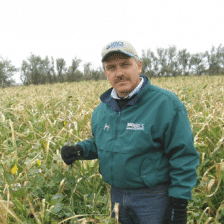
Soil health is "the continued capacity of soil to function as a vital living ecosystem that sustains plants, animals, and humans."
The soil health foundation consists of five principles:
-
- Soil Armor
- Minimizing Soil Disturbance
- Plant diversity
- Continual live plant/root
- Livestock integration.
These principles are intended to be applied in a systems approach, maximizing the soil building impact.
Soil Armor
Soil armor-or cover-provides numerous benefits for cropland, rangeland, hayland, gardens, orchards, road ditches and more.
Let's take a closer look at some of the soil armor benefits:
-
- Controlling wind and water erosion: Armor protects soil from wind and/or water as it moves across the soil surface. It holds the soil in place, along with valuable soil organic matter and nutrients
-
- Evaporation rates: Armor reduces the soil evaporation rates, keeping more moisture available for plant use
-
- Soil temperatures: Armor helps soils maintain a more moderate range of temperatures, keeping soil warmer in cold weather and cooler in hot weather. Like us, the soil food web functions best when soil temperatures are moderate
-
- Compaction: Rainfall on bare soils is one cause of soil compaction. When rainfall hits the armor instead of bare soil, much of the raindrop energy is dissipated
-
- Suppresses weed growth: Armor limits the amount of sunlight available to weed seedlings
-
- Habitat: Armor provides a protective habitat for the soil food web's surface dwellers
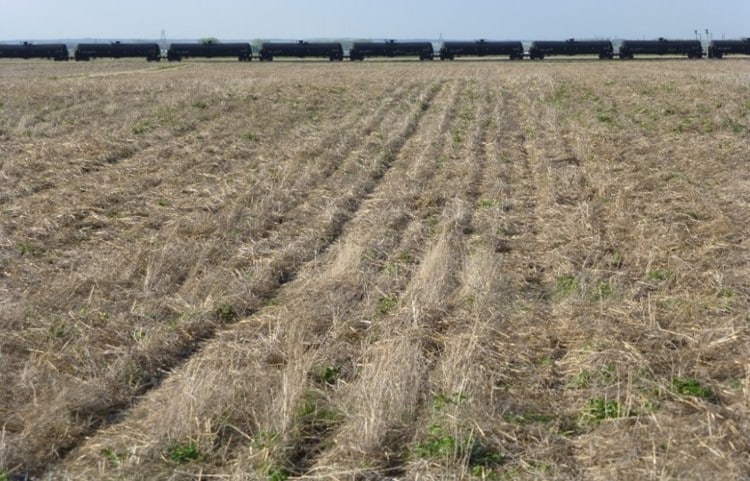
Residual armor after corn planting was completed at Menoken Farm, located just east of Bismarck, N.D. At a minimum, the armor should last until the new crop is fully canopied. How quickly this residue decomposes depends on the carbon/nitrogen ratio of the residue. High-carbon residue (eg: wheat at 80:1) decomposes much slower than low-carbon residue (eg: pea at 29:1). When we supply the soil surface with a diversity of residues from one year to the next, we can achieve the benefits of soil armor and still maintain a fully functioning nutrient cycle.
Soil armor should be evaluated by looking straight down at the soil surface and asking yourself, "What percent of the soil is protected by the residue?" Erosion needs to be controlled before you can start building soil health. The goal is to cover 100% of the soil with a green plant/residue during the growing period and residue during the dormant periods
Minimizing Soil Disturbance
Soil disturbance can generally occur in different forms:
-
- Biological disturbance, such as overgrazing, which limits the ability of the plants to harvest CO2 and sunlight
-
- Chemical disturbance, such as over application of nutrient and pesticide, can disrupt the soil food web functions
-
- Physical disturbance, such as tillage, which we will focus on in this article
A typical soil is approximately 45% mineral (sand, silt and clay); 5% soil organic matter; 25% water; and 25% air. The water and air portions exist in the pore spaces between the soil aggregates. Over time, tillage implements reduce and remove the pore spaces from our soils, restricting infiltration and destroying the biological glues that hold our soils together.
Ultimately, tillage results in one or more of the following:
-
- Water erosion: Transporting soil, nutrient and water to off-site locations, which negatively impacts water quality and quantity
-
- Wind erosion: Transporting soil and nutrient to off-site locations, which negatively impacts air quality, human health and animal health
-
- Ponding water: Staying saturated on the surface for long periods of time, a result of reduced infiltration and increased runoff
-
- Crusting easily: Restricting plant emergence
-
- Soil organic matter depletion
Can we reverse the impacts from tillage and improve soil function? Yes, we can. Minimizing soil disturbance is a good start to rebuilding soil aggregates, pore spaces, soil glue, and soil organic matter. This is an essential step for long-term soil productivity.
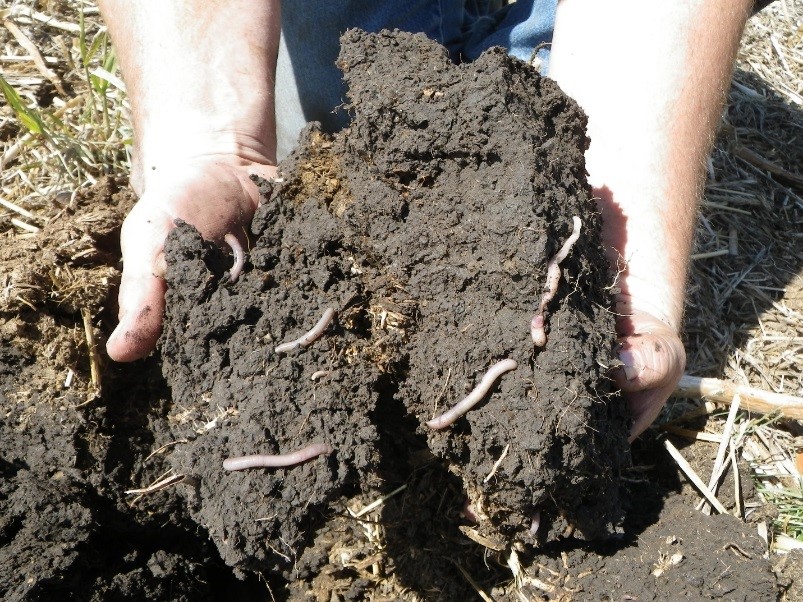
The results of more than 20 years of no tillage and crop diversity is a healthy, well-aggregated soil.
Plant Diversity
The journals of Lewis and Clark describe the northern plains landscape as having abundant plant diversity. Numerous species were observed, working together as a plant community to provide forage for large herbivore populations. Our soils were built over geological time in this environment.
However, settlement of the plains brought agriculture, which resulted in the polyculture perennial landscape being replaced by a monoculture annual landscape. Where the soil food web used to receive carbon exudates (food) from a diversity of perennial plants harvesting sunlight and carbon dioxide, it now receives carbon exudates from only one annual plant at a time.
We can start to mimic the original plant community by using crop rotations, which include all four crop types. Diverse crop rotations provide more biodiversity, benefiting the soil food web. This, in turn, improves rainfall infiltration and nutrient cycling, while reducing disease and pests.
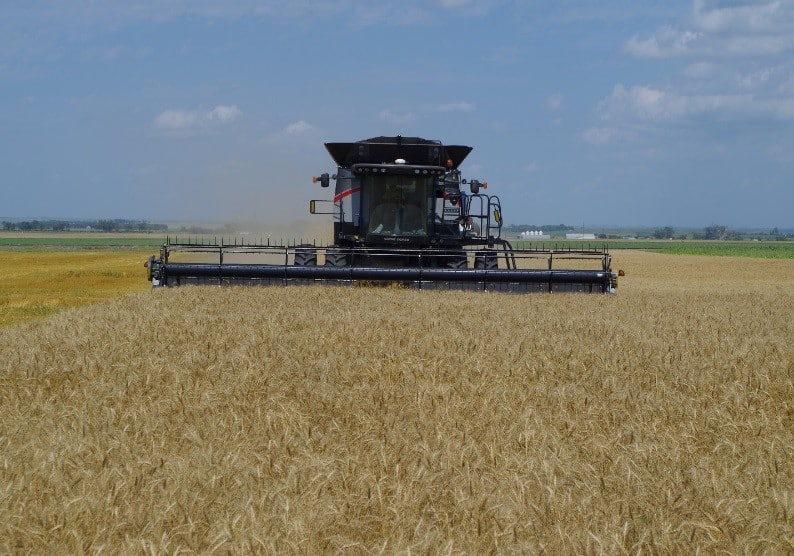
Harvesting a cool season grass (spring wheat) at Menoken Farm. Previous crops grown on this field include warm season grass (corn), cool season broadleaf (pea), warm season broadleaf (soybean) and cover crops. All supply the soil resource with the benefits of plant diversity.
Crop rotations can also be designed to include crops that are high water users; low water users; tap root; fibrous root; high-carbon crops; low-carbon crops; legumes; and non-legumes, to name a few.
The following lists the four crop types with a few common crop examples of each:
-
- Warm season grass: Corn, sudan and millet
-
- Warm-season broadleaf: Sunflower and soybean
-
- Cool-season grass: Wheat, oat, barley, and rye
-
- Cool-season broadleaf: Flax, pea and lentil
Diverse crop rotations mimic our original plant diversity landscapes. They are important to the long-term sustainability of our soil resource and food security.
Continual Live Plant/Root
Our perennial grasslands consist of cool-season grasses, warm-season grasses, and flowering forbs. Consequently, adaptable plants are able to grow during the cool spring and fall weather, as well as the summer heat. This allows for a continual live plant feeding carbon exudates to the soil food web during the entire growing season.
Our cropland systems typically grow cool- or warm-season annual cash crops, which have a dormant period before planting and/or after harvest. Cover crops are able to fill in the dormant period and provide the missing live root exudate, which is the primary food source for the soil food web.
Cover crops may be incorporated into a cropping system as annuals, biennials, or perennials. Starting on a small acre scale will allow farmers and ranchers to find the best fit for their operation.
Cover crops can address a number of resource concerns:
-
- Harvest CO2 and sunlight, providing the carbon exudates to the soil food web
-
- Building soil aggregates and pore spaces, which improves soil infiltration
-
- Cover the soil, controlling wind and water erosion, soil temperature, and rainfall compaction
-
- Catch and release of inorganic nutrients, improving water quality
-
- Salinity management, plant transpiration in lieu of soil evaporation
-
- Pollinator food and habitat
-
- Weed suppression
-
- Wildlife food, habitat, and space
-
- Livestock integration
-
- Adding crop diversity
-
- Adjusting the cover crop combination's carbon/nitrogen ratio, to either accelerate or slow decomposition

An eight-way cover crop combination was seeded after spring wheat harvest at Menoken Farm, benefiting numerous resource concerns. The cover was seeded immediately after harvest.
Livestock Integration
Animals, plants, and soils have played a synergistic role together over geological time. In recent years, animals are playing a reduced role due to being placed in confinement and fewer farms now include livestock as part of their overall operation.
Why do we want to return livestock to the landscape?
- Balanced carbon/nitrogen ratio: Fall or winter grazing to convert high-carbon annual crop residue to low-carbon organic material balances the carbon/nitrogen ratio and manages our crop rotation residue for no-till seeding
- Better regrowth: Spring or summer grazing annual and/or perennial plants with short exposure periods followed by long recovery periods allows the plants to regrow and harvest additional sunlight and CO2
- Reduced nutrient export: In lieu of transporting feed to a feedlot, we can reverse the roles and have the livestock graze the material in place, reducing nutrient export from our cropland and hayland fields. This recycles the majority of nutrients, minerals, vitamins, and carbon
- Managed weed pressure: Grazing in lieu of an herbicide helps manage weed pressure
- Higher nutritional diet: Grazing cover crops and/or crop residues allow us to take the livestock off the perennial grasslands earlier in the fall, extending the grass recovery period and providing a higher livestock nutritional diet
- Reduced livestock waste: Grazing reduces livestock waste associated with confinement, helping manage our water quality and nutrient management concerns
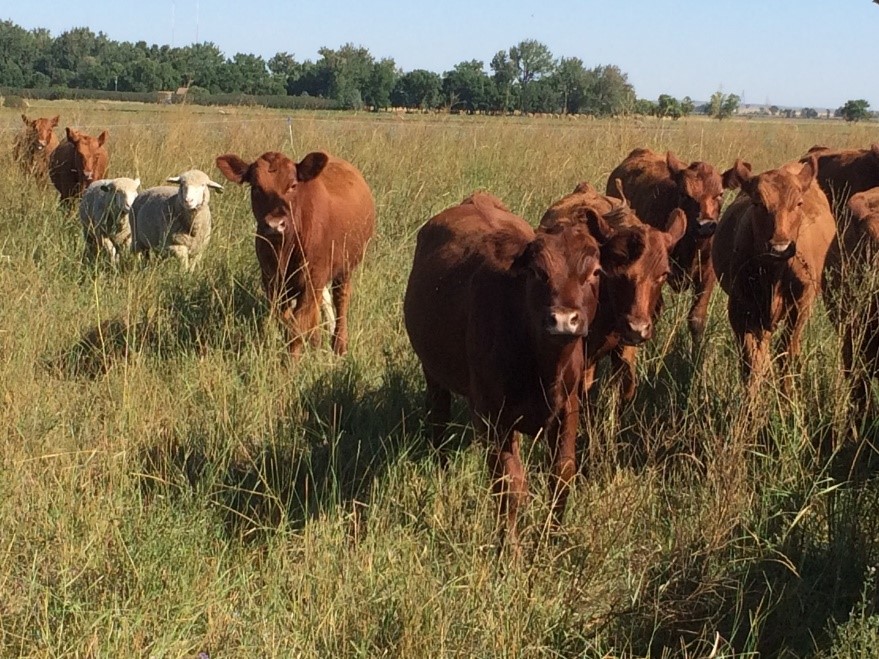
Yearlings and dry ewes graze rotational perennials, grass plants, legumes and forbs at Menoken Farm. Distributing biology across the pasture.
How do we return livestock to the landscape?
-
- Winter and fall grazing cover crops and annual crop residues
-
- Summer grazing a full-season cover crop, allowing adequate plant recovery, followed by a second grazing during the fall or winter
-
- Winter feeding on hayland fields by rolling out bales or bale grazing
-
- Seed rotational perennials, graze and manage as part of the crop rotation
By Jay Fuhrer, Natural Resources Conservation Service soil health specialist

